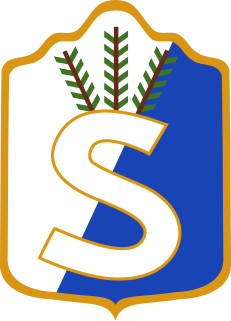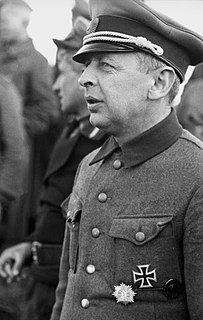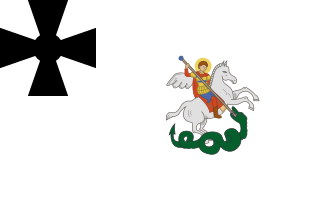
The Volkssturm was a levée en masse national militia established by Nazi Germany during the last months of World War II. It was not set up by the German Army, the ground component of the combined German Wehrmacht armed forces, but by the Nazi Party on the orders of Adolf Hitler and established on 25 September 1944. It was staffed by conscripting males between the ages of 16 and 60 years, who were not already serving in some military unit. The Volkssturm comprised one of the final components of the total war promulgated by Propaganda Minister Joseph Goebbels, part of a Nazi endeavor to overcome their enemies' military strength through force of will. Volkssturm units fought unsuccessful futile battles against the Allied forces at the end of the war and on several occasions, its members participated in atrocities accompanied by German civilians and the Hitler Youth, which were overseen by members of the SS or Gau leaders.

A militia is generally an army or some other fighting organization of non-professional soldiers, citizens of a country, or subjects of a state, who may perform military service during a time of need, as opposed to a professional force of regular, full-time military personnel; or, historically, to members of a warrior-nobility class. Generally unable to hold ground against regular forces, militias commonly support regular troops by skirmishing, holding fortifications, or conducting irregular warfare, instead of undertaking offensive campaigns by themselves. Local civilian laws often limit militias to serve only in their home region, and to serve only for a limited time; this further reduces their use in long military campaigns.

Organisation Todt was a civil and military engineering organisation in Nazi Germany from 1933 to 1945, named for its founder, Fritz Todt, an engineer and senior Nazi. The organisation was responsible for a huge range of engineering projects both in Nazi Germany and in occupied territories from France to the Soviet Union during World War II. It became notorious for using forced labour. From 1943 until 1945 during the late phase of the Third Reich, OT administered all constructions of concentration camps to supply forced labour to industry.

The White Guard or Civil Guard was a voluntary militia, part of the Finnish Whites movement, that emerged victorious over the socialist Red Guards in the Finnish Civil War of 1918. They were generally known as the "White Guard" in the West due to their opposition to the "communist" Red Guards. In the White Army of Finland many participants were recruits, draftees and German-trained Jägers – rather than part of the paramilitary. The central organization was named the White Guard Organization, and the organization consisted of local chapters in municipalities.

The Home Guard was an armed citizen militia supporting the British Army during the Second World War. Operational from 1940 to 1944, the Home Guard had 1.5 million local volunteers otherwise ineligible for military service, such as those who were too young or too old to join the regular armed services and those in reserved occupations. Excluding those already in the armed services, the civilian police or civil defence, approximately one in five men were volunteers. Their role was to act as a secondary defence force in case of invasion by the forces of Nazi Germany.

Bronislav Vladislavovich Stroganof Kaminski was a Russian Nazi collaborator and the commander of the Kaminski Brigade, an anti-partisan and rear-security formation made up of people from the so-called Lokot Autonomy territory in the Nazi Germany occupied areas of the Soviet Union, which was later incorporated into the Waffen-SS as the SS Sturmbrigade RONA. Older publications mistakenly give his first name as Mieczyslaw. Under Kaminski's command, the unit committed numerous war crimes and atrocities in the German-occupied Soviet Union and Poland.

The Lokot Autonomy or Lokot Republic was an autonomous structure on the territory of the Central Russian oblasts of Bryansk, Oryol and Kursk from July 1942 to August 1943.

The Ordnungspolizei, abbreviated Orpo, meaning "Order Police", were the uniformed police force in Nazi Germany from 1936 to 1945. The Orpo organisation was absorbed into the Nazi monopoly on power after regional police jurisdiction was removed in favour of the central Nazi government. The Orpo was controlled nominally by the Interior Ministry, but its executive functions rested with the leadership of the SS until the end of World War II. Owing to their green uniforms, Orpo were also referred to as Grüne Polizei. The force was first established as a centralised organisation uniting the municipal, city, and rural uniformed police that had been organised on a state-by-state basis.

Auxiliaries are support personnel that assist the military or police but are organised differently from regular forces. Auxiliary may be military volunteers undertaking support functions or performing certain duties such as garrison troops, usually on a part-time basis. Unlike a military reserve force, an auxiliary force does not necessarily have the same degree of training or ranking structure as regular soldiers, and it may or may not be integrated into a fighting force. Some auxiliaries, however, are militias composed of former active duty military personnel and actually have better training and combat experience than their regular counterparts.

The Reich Labour Service was a major organisation established in Nazi Germany as an agency to help mitigate the effects of unemployment on the German economy, militarise the workforce and indoctrinate it with Nazi ideology. It was the official state labour service, divided into separate sections for men and women.

Home guard is a title given to various military organizations at various times, with the implication of an emergency or reserve force raised for local defense.

SS Heimwehr "Danzig" was an SS unit established in the Free City of Danzig before the Second World War. It fought with the German Army against the Polish Army during the invasion of Poland, and some of its members committed a massacre of Polish civilians. After this it became part of the 3rd SS Totenkopf Division and ceased to exist as an independent unit.

The Feldgendarmerie were a type of military police units of the armies of the Kingdom of Saxony, the German Empire and Nazi Germany until the conclusion of World War II in Europe.
Security Divisions were German rear-area military units engaged in Nazi security warfare in occupied Europe during World War II. Almost all divisions were employed in areas on the Eastern front with the exception of the 325th Security Division which operated within Occupied France. The units were tasked with fighting local partisans, intelligience and counter-insurgency against resistance groups, rounding up Jews and other ethnic groups as part of The Holocaust, and conducting punitive actions in civilian areas.

Operation N was a complex of sabotage, subversion and black-propaganda activities carried out by the Polish resistance against Nazi German occupation forces during World War II, from April 1941 to April 1944. These activities were organized by Office N, which in October 1941 was transformed into an Autonomous Sub-Department N of the Bureau of Information and Propaganda of the Armed Resistance, later of the Home Army. It was headed by Tadeusz Żenczykowski.

Law enforcement in Poland consists of the Police (Policja), City Guards, and several smaller specialised agencies. The Prokuratura Krajowa and an independent judiciary also play an important role in the maintenance of law and order.

The Omakaitse was a militia organisation in Estonia. It was founded in 1917 following the Russian Revolution. On the eve of the Occupation of Estonia by the German Empire the Omakaitse units took over major towns in the country allowing the Salvation Committee of the Estonian Provincial Assembly to proclaim the independence of Estonia. After the German Occupation the Omakaitse became outlawed.

The Home Guard of the several states of the Confederacy during the American Civil War included all able-bodied white males between the ages of 18 and 50 who were exempt from Confederate service, excepting only the governor and other officials. The Home Guard replaced the militia whose members had volunteered or been conscripted into service in the Confederate Army.
Destruction battalions, colloquially istrebitels abbreviated: istrebki (Russian), strybki (Ukrainian) were paramilitary units under the control of NKVD in the western Soviet Union, which performed tasks of internal security on the Eastern Front and after it. After the Fall of the Soviet Union the battalions were deemed by the Riigikogu to be a criminal organisation.
The Ustaše Militia was the military branch of the Ustaše, established by the fascist regime of Ante Pavelić in the Independent State of Croatia (NDH), an Axis puppet state established from a large part of occupied Yugoslavia during World War II.